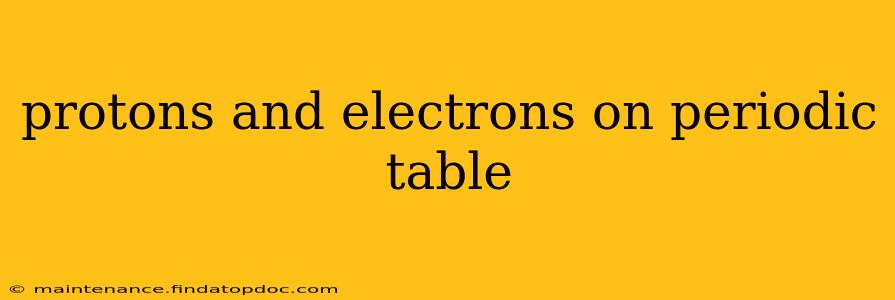The periodic table, a cornerstone of chemistry, organizes elements based on their atomic structure. Understanding the relationship between protons and electrons and their representation on the periodic table is crucial to grasping the fundamental principles of chemistry. This guide delves into the details, answering common questions and providing a comprehensive overview.
What are Protons and Electrons?
Before exploring their role on the periodic table, let's define these subatomic particles:
-
Protons: Positively charged particles found in the nucleus (center) of an atom. The number of protons defines the element's atomic number and its identity. For example, all hydrogen atoms have one proton, all helium atoms have two, and so on.
-
Electrons: Negatively charged particles that orbit the nucleus in shells or energy levels. Electrons are much smaller and lighter than protons and are responsible for the chemical behavior of an element. In a neutral atom, the number of electrons equals the number of protons.
How are Protons and Electrons Represented on the Periodic Table?
The periodic table cleverly encodes information about protons and electrons. Let's break it down:
-
Atomic Number: The number displayed above each element's symbol represents the atomic number. This number is equal to the number of protons in the nucleus of an atom of that element. This is the most fundamental piece of information provided.
-
Atomic Mass: Found below the element's symbol, atomic mass represents the average mass of an atom of that element. While not directly related to the number of electrons, it's influenced by the number of protons and neutrons (neutral particles in the nucleus). The mass number (which may vary for isotopes of an element) accounts for both protons and neutrons.
-
Electron Configuration (implied): While not explicitly shown on the standard periodic table, the arrangement of elements reveals information about electron configuration. Elements in the same group (column) share similar outer electron shell configurations, leading to similar chemical properties. This is why elements in the same group often exhibit similar reactivity.
How Many Electrons Does an Element Have?
In a neutral atom (the typical assumption when dealing with the periodic table), the number of electrons is equal to the number of protons. This is because atoms have a neutral charge; the positive charge of the protons is balanced by the negative charge of the electrons. However, atoms can gain or lose electrons to form ions, which have a net positive or negative charge.
How to determine the number of electrons in an ion?
To find the number of electrons in an ion, you start with the number of protons (atomic number) and then add or subtract electrons based on the ion's charge. For example:
- Na⁺ (sodium ion): Sodium's atomic number is 11, meaning it has 11 protons in a neutral atom. The +1 charge indicates it has lost one electron, resulting in 10 electrons.
- O²⁻ (oxide ion): Oxygen's atomic number is 8. The -2 charge signifies that it has gained two electrons, for a total of 10 electrons.
What are Isotopes and How do they relate to Protons and Electrons?
Isotopes are atoms of the same element that have the same number of protons but a different number of neutrons. This means isotopes of an element have the same atomic number (and therefore the same number of electrons in a neutral atom) but different atomic masses. The differing neutron number doesn't change the number of protons or (in neutral atoms) electrons.
What are Ions and how do they affect the number of Electrons?
Ions are atoms that have gained or lost electrons, resulting in a net positive or negative charge. Cations are positively charged ions (lost electrons), while anions are negatively charged ions (gained electrons). The number of protons remains constant, but the electron count changes, altering the atom's overall charge.
This detailed explanation provides a thorough understanding of protons and electrons' significance in the context of the periodic table. By grasping these fundamental concepts, you'll be better equipped to understand the chemical behavior of elements and their interactions.
